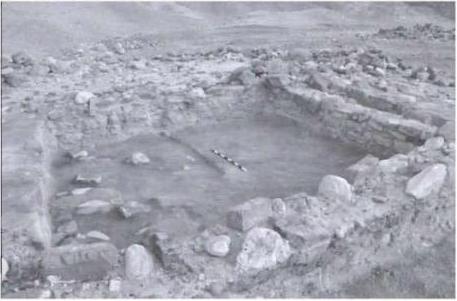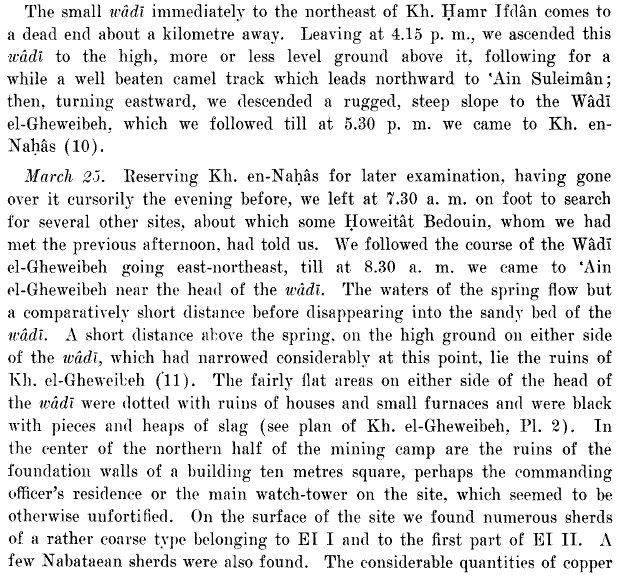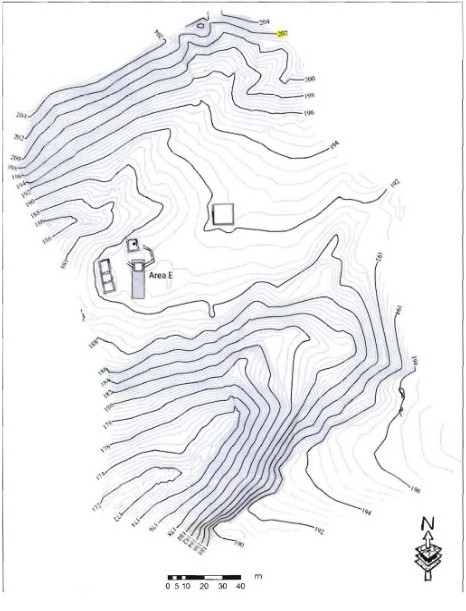|
Other Archaeological Sites / The Neolithic of the Levant (500 Page Book Online) PreHistoric Khirbat al-Ghuwayb Updated April 1st
Challenges for a Regional Perspective on Iron Age Metal Production in Faynan: As part of the Edom Lowlands Regional Archaeology Project (ELRAP) that has focused on the role of Iron Age metal production in socio-cultural change during the late 2nd and early 1st millennia BC, we carried out a small-scale test excavation at Khirbat al-Ghuwayb in order to compare and contrast one of the smaller copper production centers in Faynan with the largest ones known at Khirbat en-Nahas (KEN) and Khirbat al-Tariya (Levy et al 2010) ... The new archaeological data concerning the location of Khirbat al-Ghuwayb in relation to its immediate landscape hinterland, radiocarbon dates published here for the first time and the site's relationship to the main centers of Iron Age copper production provide new insights into the regional historical and socio-economic processes of settlement in the Faynan copper ore district. The three largest Iron Age copper smelting sites include (in order of size): Khirbat en-Nahas (Levy et al 2008), the environs of Khirbat Faynan (Mattingly et al 2007) and Khirbat al-Tariya (Ben-Yosef et al 2010). In terms of size and importance Khirbat al-Ghuwayb (KAG) is the fourth major smelting center that must be factored into any Iron Age settlement pattern study of Faynan. The site of Khirbat al-Ghuwayb is a large copper production site located in the upper part of Wadi al-Ghuwayb in the north-eastern region of Faynan. The site is adjacent to the oasis of Ayn al-Ghuwayb whose lush grove (Arab ghuweiba) of tamarisk and other hydrophilic plants gave the ruins (Arab khirbah), dry river (Arab wadi) and spring (Arab ayn) their names. This major site was surveyed in the past by various scholars but without the kind of precision and diachronic study demonstrated here. Khirbat al-Ghuwayb was first visited by Nelson Glueck in the 1930s (1935: 22-23 and 164 -- Plate 162). He dated the smelting remains at the site mostly to the early Iron Age:
Explorations in Eastern Palestine II in The Annual of the American Schools of Oriental Research
It is interesting to compare Glueck's observation with the comments of Weisgerber (2006: 15): "[...] at Khirbat al-Ghuwayba was another seemingly unsuccessful smelting site. Perhaps the yield in copper ore there did not meet expectations". Indeed the extensive scatter of slag on the surface is rather thin and less substantial than the nearby smelting sites of Khirbat en-Nahas and Khirbat al-Jariya. The large slabs of tap slag, abundant on the surface of KEN, are completely absent and there are no substantial 'mounds' as at other Iron Age smelting sites in Faynan. However, as will be suggested below in light of the recent 14C dates from KAG, the density differences of surface slag at the different Iron Age smelting centers in Faynan may be linked to both chronology and technological practice during the Iron Age sequence in Faynan [italics added] (circa 1200-500 BC). The site extends over 7 hectares (70 dunams) on both sides of Wadi al-Ghuwayba near the perennial spring of Ayn al-Ghuwayba ... Although the archaeological site is quite extensive in area the archaeological accumulation is rather shallow and in most places is composed of only thin scatter of broken slag (especially on the southern bank). Some substantial structures are visible on the surface and a few are concentrated on the northern bank near a seasonally active bedouin encampment.
The southern bank portion of Khirbat al-Ghuwayba is characterized by many small tumuli rather than rectangular or square architectural features. Most of the slag scatter is not associated with substantial structures and the southern bank is almost completely devoid of substantial architectural features. The spring of Ayn al-Ghuwayba is located between the two banks of the wadi, a small cemetery is located to the northwest of Area E and the fortress of Ras al-Miyah West is visible from the site, located almost directly north of it.
KAG Area E: the Structure
 The excavation of the small square structure in Area E concluded with the exposure of a room dated to
the Roman-Nabataean period on the basis of the glass and pottery assemblages and small finds. The room contained several hearths and abundant carbon samples were collected from the floor levels. Beneath the fill we found several hearths and ash pockets with large accumulations of charcoal in addition to a large quantity of glass fragments -- pottery sherds and one playing die ... Based on our extensive excavation of Iron Age structures at KEN and KAJ it was apparent that the building technique represented at Khirbat al-Ghuwayba Area E is quite different and reflects both cultural and chronological differences.
The excavation of the small square structure in Area E concluded with the exposure of a room dated to
the Roman-Nabataean period on the basis of the glass and pottery assemblages and small finds. The room contained several hearths and abundant carbon samples were collected from the floor levels. Beneath the fill we found several hearths and ash pockets with large accumulations of charcoal in addition to a large quantity of glass fragments -- pottery sherds and one playing die ... Based on our extensive excavation of Iron Age structures at KEN and KAJ it was apparent that the building technique represented at Khirbat al-Ghuwayba Area E is quite different and reflects both cultural and chronological differences.
KAG: Chronology and its Implications
Conclusions: Spread out over an area of some 7 hectares on both banks of the wadi that bears its name, the slag scatter of Khirbat al-Ghuwayb dominates the landscape of a remote location in the copper ore district of Faynan. This site played an important role in the earliest Iron Age occupation of the Faynan district. To date no pre-Iron Age occupation has been recorded in the perennial spring environs of Wadi al-Ghuwayb where the ruins are located. The site was the locus of periodic Nabataean settlement from the end of the 4th century BC until the annexation of the Nabataean kingdom by Rome in 106 AD (Schmid 2008). To date there is no evidence of copper production at the site during this period (nor at any other copper production site in the Wadi al-Ghuwayb basin). Owing to the extensive Arabian trade network controlled by the Nabataeans at this time, virtually every easily accessible perennial water source in the southern Levantine desert zone was exploited and KAG is typical of this phenomenon. Thus trans-regional trade, rather than copper production, was the catalyst for Nabataean occupation at KAG (see also Ben-Yosef et al). As part of our general research to examine the Iron Age copper production landscape of Faynan, the preliminary research at KAG presents important information concerning the beginnings of the process of Iron Age industrialization in Faynan. Unlike the peak centuries of Iron Age copper production (10th-9th centuries BC) when the massive production site of Khirbat en-Nahas was the center of production on the margins of the Arabah Valley, during the initial phases of Iron Age copper production, sites such as KAG and Khirbat al-Jariya were more scattered and located in hidden valleys -- far from the open reaches of the Arabah plains. Khirbat Faynan and its extensive network of desert farm land may also have been an important early Iron Age center of settlement (Mattingly et al 2007) ... |


 An area of relatively thick slag accumulation associated with some surface structures was selected for excavation on the northern bank of Wadi al-Ghuwayba ("Area E"). The main goals were to date the copper production activities
at the site, to characterize the smelting technology and to check the function of a nearby structure that may have been related to copper production activities. Clarifying the chronology of the site was of particular interest to our general investigation of the oscillation in copper production activities throughout the Iron Age (Levy et al). As the nearby mining sites of Ras al-Miyah were dated by abundant ceramics to the late Iron Age (Iron Age IIB - C) (Ben-Yosef el al 2009), we speculated that Khirbat al-Ghuwayba was the smelting counterpart of the mines and also dated to the late Iron Age (Ben-Yosef et al 2009). Based on our surveys and those of other researchers in the vicinity of those mines, and in other nearby areas in the Faynan region that have been investigated to date, there are no good other 'candidates' for smelting sites associated with these mines.
An area of relatively thick slag accumulation associated with some surface structures was selected for excavation on the northern bank of Wadi al-Ghuwayba ("Area E"). The main goals were to date the copper production activities
at the site, to characterize the smelting technology and to check the function of a nearby structure that may have been related to copper production activities. Clarifying the chronology of the site was of particular interest to our general investigation of the oscillation in copper production activities throughout the Iron Age (Levy et al). As the nearby mining sites of Ras al-Miyah were dated by abundant ceramics to the late Iron Age (Iron Age IIB - C) (Ben-Yosef el al 2009), we speculated that Khirbat al-Ghuwayba was the smelting counterpart of the mines and also dated to the late Iron Age (Ben-Yosef et al 2009). Based on our surveys and those of other researchers in the vicinity of those mines, and in other nearby areas in the Faynan region that have been investigated to date, there are no good other 'candidates' for smelting sites associated with these mines.